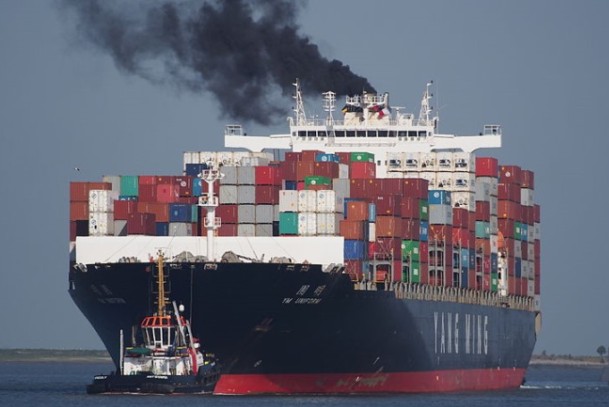
Joy Dimka, Senior Legal Officer, Nigerian Shippers' Council.
Follow Joy Dimka
![]() @JoyDimka
@JoyDimka
Subjects of Interest
- Energy
- International Trade
- Law and Society
The new IMO regulations on emissions by ships 13 Mar 2020

A ship emitting thick smoke into the atmosphere
The International Maritime Organization (IMO) has been working for over a decade to regulate the sulphur content in fuel oil used by ships. Airborne emissions from ships such as sulphur oxides (SOx), nitrogen oxides (NOx) and other substances contribute to global air pollution and they are particularly harmful to the health of populations living close to ports and coasts.
There are various pollution limits set for ships operating in and outside Emission Control Areas (ECAs), also known as Sulfur Emission Control Areas (SECAs). Typically, the IMO ship pollution regulations are contained in the International Convention for the Prevention of Pollution from Ships (or Marine Pollution: MARPOL) under “Annex VI,” titled “Regulations for the Prevention of Air Pollution from Ships.” Annex VI came into effect on May 19, 2005. Five years later, the revised regulations entered into force on July 1, 2010.
The latest amendment to the regulation limiting sulphur content of ships’ fuel oil came into effect on January 1, 2020. From the year 2000 to 2012, ships operating outside ECAs had a fuel oil pollution limit of 4.5% m/m (mass by mass); the limit dropped to 3.5% m/m between 2012 and December 2019. Effective January of this year, the new limit is 0.5% m/m. The stricter amendments of Annex VI aim to progressively reduce global emissions of SOx, NOx, and particulate matter.
Ships operating within ECAs observe stricter controls. The existing ECAs in the world include the Baltic Sea, the North Sea, North American ECA (which includes most of the USA and Canada), US Caribbean ECA (including Puerto Rico and the US Virgin Islands). The sulphur limit for these areas was at 1.5% m/m between 2000 and 2010, before it dropped to 1.0% m/m in 2010. The ECAs currently face stricter limit of 0.1% m/m, which has been in place since 2015.
The regulation aligns with the Kyoto Protocol – the international agreement that commits countries to limit and reduce greenhouse gases (GHG) emissions, which cause global warming. Having adopted the protocol in 1997, the IMO has conducted various studies to estimate shipping emissions. The IMO's third GHG Study, published in 2014, estimated shipping emissions based on 2012 level to be 796 million tonnes, or about 2.2 per cent of the global total anthropogenic carbon dioxide (CO2) emission.
The Sox is potently harmful to the environment. When emitted into the atmosphere, it can lead to acid rain, which is harmful to crops, forests and aquatic species. It also contributes to the acidification of the oceans. According to the IMO, limiting SOx emissions from ships will improve air quality and protect the environment.
The process of setting the sulfur limit was coordinated by a committee made up of the 173 IMO member states, the shipping industry and the fuel oil suppliers. Based on the new global sulphur limit, the IMO estimates that SOx emissions from ships would drop by about 8.5 million tonnes on an annual basis.
The shipping industry has been one of the consumers of the dirtiest forms of fossil fuels. But alternatives to such low-grade, high-sulphur fuel oil are increasingly available, although they are more expensive. The uptake of liquefied natural gas (LNG), which is still a fossil fuel but much cleaner, has also increased in the industry. Renewable energy sources, such as biofuels, are also being explored as alternatives to fossil fuels. The industry is also looking at harnessing hydrogen fuels in the form of ammonia to be used in ship engines.
Monitoring, compliance and enforcement of the new limit is within the jurisdiction of governments and national authorities of member states that are Parties to MARPOL Annex VI. According to the regulation, non-compliance can lead to imposition of fines and even detention in some cases. A detained ship can only be released after the ship owner has paid the stipulated fines and met the regulatory standards.
Nigeria is a signatory to the MARPOL 73/78/97 conventions (including their amendments and consolidations). Following the 2020 amendment, the marine environment departments of both the Nigerian Ports Authority (NPA) and the Nigerian Maritime Administration and Safety Agency (NIMASA) have said they are coming up with the best possible approaches to implementing the regulations.
The new regulations would increase economic activity in the maritime industry. For one, ship owners would have to invest more to avail themselves of Protection and Indemnity (P&I) insurance, which is a marine insurance provided to ship owners, operators and seafarers.
While insurance can provide cover for fines in the event that ships violate the emission standards, the port authorities would have generated additional revenue for the government from taxes. This also means the government would have to invest in amperometric analyzers and other forms of equipment used in measuring atmospheric sulphur oxides to ensure that vessels coming in and out of Nigerian ports do not flout the regulations.
Latest Blogs By Joy Dimka
- Prospects of port community system in Nigeria’s maritime sector
- Nigeria’s WCO chairmanship as opportunity for trade facilitation
- Nigeria and the International Oil Pollution Compensation Fund
- Challenges and opportunities in Nigerian marine fuels market
- Historical insights for Nigerian Cabotage Vessel Financing Fund






